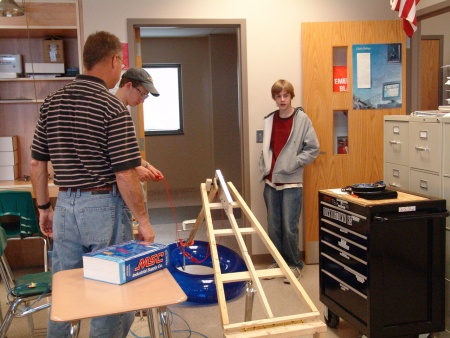Difference between revisions of "DEWBOT III Arm"
MaiKangWei (talk | contribs) (→Original Arm Mechanics) |
MaiKangWei (talk | contribs) (→Original Arm Mechanics) |
||
| Line 12: | Line 12: | ||
Dewbot III's elbow was driven by a pair of Nisso-Denso motors (L & R) with a 4:1 "gear" reduction via 10 & 40-tooth timing belt pulleys. A 270° potentiometer provides elbow angle information. | Dewbot III's elbow was driven by a pair of Nisso-Denso motors (L & R) with a 4:1 "gear" reduction via 10 & 40-tooth timing belt pulleys. A 270° potentiometer provides elbow angle information. | ||
| − | The original Gripper was a | + | The original Gripper was a simple pneumatically-actuated vertically-oriented claw which grabbed the ringers center-to-outside. |
| + | |||
| + | Both arm sections were fabricated from Aluminum tubing, braized/welded with Zinc (like the frame). This produced a strong, lightweight arm. This joining method was satisfactory. | ||
| + | |||
| + | The first-generation Gripper proved to be awkward. It was difficult to hang the ringers on the Rack and especially difficult to successfully disengage afterwards. This Gripper was used only during DEWBOT III's first competition (Pittsburgh) before being replaced with an improved design. | ||
==Improved Gripper== | ==Improved Gripper== | ||
Revision as of 12:07, 11 August 2009
Dewbot III ended up with an effective arm for scoring, but this arm had a difficult birth.
The Arm used on Dewbot III has three articulations:
- A hinge shoulder driven by a pneumatic cylinder
- A hinge elbow driven by motors and monitored via potentiometer
- A gripper driven by pneumatic cylinder
Original Arm Mechanics
The Shoulder articulation was used to deploy the arm for play from the robot's initial staring position. The pneumatic cylinder (Bimba xxx) was retracted and the shoulder folded back for the start of competition (this kept the robot within the FRC starting envelope dimensions). At the start of Autonomous Play, DEWBOT III's compressor came on and the Shoulder deployed to the forward position. The Shoulder could also be actuated during the game to allow bi-directional play (picking up ringers on one side of the robot and scoring on the other) or to manage center-of-mass when climbing ramps at the match end for bonus points. Bi-directional play was seldom used in practice.
Dewbot III's elbow was driven by a pair of Nisso-Denso motors (L & R) with a 4:1 "gear" reduction via 10 & 40-tooth timing belt pulleys. A 270° potentiometer provides elbow angle information.
The original Gripper was a simple pneumatically-actuated vertically-oriented claw which grabbed the ringers center-to-outside.
Both arm sections were fabricated from Aluminum tubing, braized/welded with Zinc (like the frame). This produced a strong, lightweight arm. This joining method was satisfactory.
The first-generation Gripper proved to be awkward. It was difficult to hang the ringers on the Rack and especially difficult to successfully disengage afterwards. This Gripper was used only during DEWBOT III's first competition (Pittsburgh) before being replaced with an improved design.
